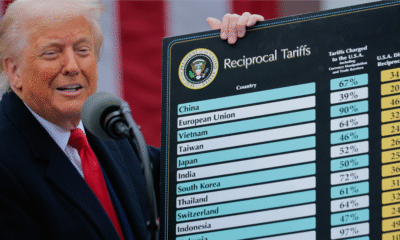Trade
‘India-US Trade Policy Forum has key role in deepening understanding of each other’s positions’
The India-US Trade Policy Forum has a key role to play in deepening the understanding of each other’s positions in a non-negotiating, non-transaction-oriented setting, according to a former top commerce official in the Obama administration, who welcomed the revival of the key platform to further enhance bilateral trade ties.
During her maiden visit to India last month, United States Trade Representative (USTR) Katherine Tai had her first Trade Policy Forum (TPF) meeting with Commerce Minister Piyush Goyal. The meeting was held after a gap of four years.
Also read: HCL Tech announces plan for 12,000 new jobs in US
I see the engagement as positive. It was important that face-to-face ministerial level conversations were held between the two governments, said Arun Kumar, who is at the end of his five-year term as Chairman and CEO of KPMG India, an assignment he took on after completing his tenure as Assistant Secretary of Commerce for Global Markets and Director General of the US and Foreign Commercial Service in the Obama administration.
The Trade Policy Forum met after four years. I had the privilege of participating in the Forum when I served in the Obama administration. I believe it is a valuable platform for constructive discussion. It has a key role to play in deepening understanding of each other’s positions in a non-negotiating, non-transaction oriented setting, Kumar told PTI in a recent interview.
Kumar, who was in Washington DC on a personal visit, said an important aspect of the talks this time is that it recognised the importance of labour and environmental standards. Such topics are today seen as essential elements of high quality trade agreements. With regard to more specific issues, progress was made on market access for farm products in both directions, mangoes and pomegranates to the US, and cherries, alfalfa and pork products to India, he said.
Responding to a question on the 11-month of the Biden administration, Kumar said the good news is that trade and commerce between the US and India continue to grow. The US is India’s largest trade partner today, Kumar noted. Foreign Direct Investment (FDI) from the US into India has been robust and growing. On the government-to-government front, talk of a mini-deal receded even as the Biden administration was expectedly focused on domestic priorities, he said.
The visit of Ambassador Katherine Tie should be seen as a step towards creating forward movement on the policy front. The visit follows the meeting of President (Joe) Biden and Prime Minister (Narendra) Modi at the White House in September that, alongside the Quad leaders meeting, focused on security, global health and climate change. “The engagement on trade, coming within two months of the leaders’ meeting, is a signal of the importance of the economic partnership, Kumar said.
According to Kumar, there are several areas of contention ranging from GSP (Generalised System of Preferences) to issues related to digital trade and data. Most important, in my view, is to address issues relating to the digital economy as the world moves at an increasing pace towards e-commerce including digital payments. Getting to the right answers will mean much for both economies, through enabling access to larger markets and creating more jobs, he said.
GSP is the largest and oldest US trade preference programme, which promotes economic development by eliminating duties on thousands of products when imported from one of 119 designated beneficiary countries and territories. Kumar, in response to a question, suggested greater business-to-business engagement, providing as much priority to export promotion as on policy advances that are government-led.
Such engagement should be energised at the sub-national level, with US state governors and Indian chief ministers taking the lead. We have successful examples in both countries where a dynamic state leader has made demonstrable differences through their initiatives and focused engagement, he said. Both the US and India have federal structures where the states need to be the engines that drive growth. My recommendation to both the governments would be to prioritise such engagement between states with business leaders working alongside, Kumar added.
Observing that the topography of world trade has moved in many ways over the last five years, he said the world will hopefully emerge from the isolationist trends marked by Brexit and the Trump administration’s postures. We are seeing regional multilateral groupings, the Regional Comprehensive Economic Partnership (RCEP) and the Comprehensive and Progressive Agreement for Trans-Pacific Partnership (CPTPP) making progress — even though unevenly. Modern supply chains snake through multiple countries; increasing the importance of multilateral approaches, Kumar said.
The importance of supply chain resilience was brought into focus by the US- China trade issues and then exacerbated by the pandemic. Over-reliance on a single geographic area is clearly unwise. In addition, as countries and corporations aim to become carbon neutral or carbon negative, the quality and monitoring of supply chains for their environmental impact assume even greater importance, he added.
The US and India are both bystanders with regard to the Regional Comprehensive Economic Partnership (RCEP) and CPTPP, for different reasons. While RCEP is a China-led configuration, the Comprehensive and Progressive Agreement for Trans-Pacific Partnership (CPTPP) is relatively a high standard agreement modelled on the Trans-Pacific Partnership (TPP), Kumar noted.
It has been suggested that both the US and India should actively consider entry into the CPTPP. As a step in that direction, it makes conceptual sense to directionally consider a US-India Free Trade Agreement. The North American Free Trade Agreement (NAFTA) was a stepping stone to the erstwhile TPP and then the CPTPP. NAFTA was of course superseded by the US-Mexico Canada Agreement (USMCA) as NAFTA, after over 25 years, was in need of updating, he said.
Trade agreements are not easy to do. They are politically very difficult in democracies; while the goal is for the overall economy to benefit, there will be local losers who would need to be assisted, Kumar said. While the Quad is in concept a security oriented grouping, it is encouraging to see it also become a platform for conversation in areas spanning healthcare, technology and financing, he said.
Known as the “Quadrilateral Security Dialogue”, Quad is a four-nation bloc comprising India, the US, Australia and Japan that strives to keep the critical sea routes in the Indo-Pacific free of any influence. Studies have shown there is a compelling case for broader economic collaboration among the Quad countries in tariff reduction and market access. Equally, a structure like the CPTPP would be more comprehensive and worthy of consideration to address the goals of a larger free trade area to expand economic growth and jobs in all the countries, Kumar said.









































